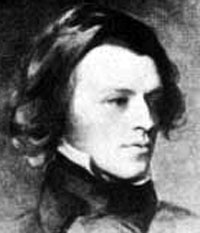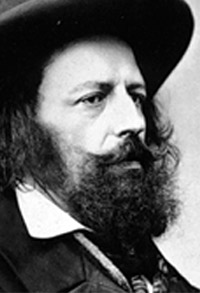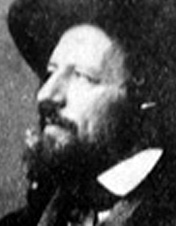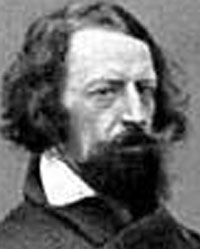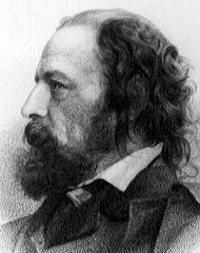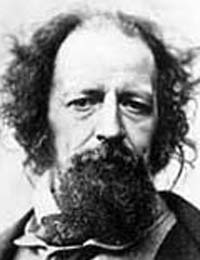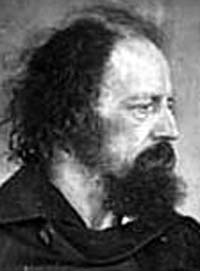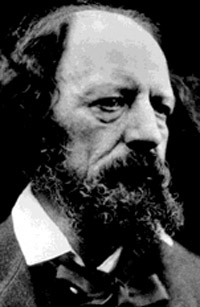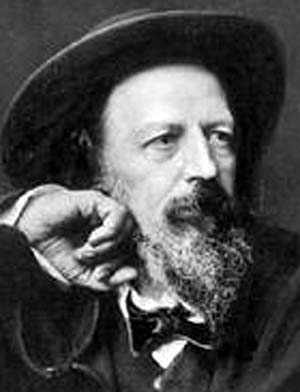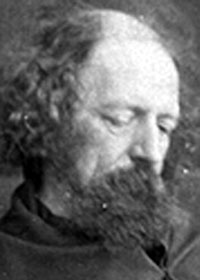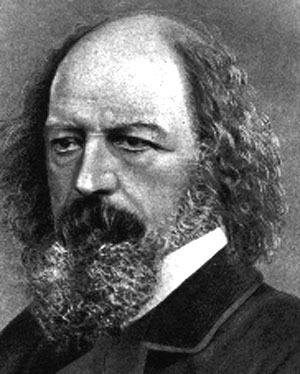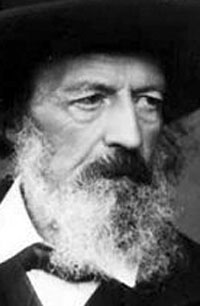Copyright Michael D. Robbins 2002
Astro-Rayological Interpretation & Charts
Quotes
Biography
Images and Physiognomic Interpretation
August 6, 1809, Somersby, England; 12:05 AM LMT
(Source: Sabian Symbols and Notable Nativities; also from him—“a few minutes after midnight”)
Died, October 6, 1892, Aldworth, England.
(Ascendant Gemini with Venus in Gemini rising and the Moon also in Gemini; MC, Aquarius; Sun, Leo; Mercury, Cancer; Mars conjunct Uranus in Scorpio; Jupiter, Aries; Saturn in Scorpio conjunct Neptune in Sagittarius; Pluto, Pisces)
Alfred Tennyson was one of the England’s greatest poets, the most famous poet of the Victorian Age, and a profound voice for the values of his cultural era. He is, in fact, acclaimed by many as one of the greatest poets of all time, due to the sheer beauty of his words, his notable mastery of technique, his superb use of sensuously evocative language, his sensitive employment of a variety of metric forms, and his profundity of thought. During most of his life he was celebrated by both critics and the public, “lionized” by his contemporaries in Victorian society. He became the very embodiment of the Victorian “poet laureate” to which post he was appointed by Queen Victoria in 1850. Queen Victoria was a triple Gemini, and, hence, her appreciation of Tennyson—based in part on astrological synastry.
Tennyson was a sensitive and troubled individual inclined to melancholy. Mental illness was part of his family heredity, afflicting his father and his three brothers as well. He, too, was for a time treated for mental problems (from the appearance of the horoscope, probably a form of depression), and was also victim of a mild form of epilepsy which ran in the family. But for all his personal doubts and fears, his poetry had an altogether inspiring effect upon his readers. Through the spaciousness and nobility of his best verse, his graceful and harmonious phrasing, his palpable sense of awe before the mystery of life—through his poetic mastery altogether—he was able to convey a feeling of confidence, reassurance and deep serenity.
To read Tennyson is to experience the struggles of a soul immersed in a period of changing perceptions about the nature, place and value of the human being. The evolutionary theories of Darwin had made thinking people question the pedigree of man, his relation to his fellow human beings and to God. A strong materialistic strain was running through the second half of the nineteenth century undermining humanity’s conviction of its own nobility, its own distinction from the animal nature. All of this distressed Tennyson, who despite his own misgivings, and awareness of the implications of the new thought streams, emerged as the champion of the immortality of the soul. Defiantly he refused to accept the materialistic conclusion, and in this refusal spoke for the heart and hope of his society.
Major Works
“Timbuctoo” (1829); “Poems, Chiefly Lyrical” (1830 and 1842), including “The Lotus-Eaters,” “A Dream of Fair Women,” and “The Lady of Shalott.”, in an the later edition, “Locksley Hall,” “Ulysses,” “Morte d’Arthur,” and “Break, Break, Break”; "The Two Voices" (of which the original title, significantly, was "Thoughts of a Suicide"), "Ulysses," "St. Simeon Stylites" (c. 1834-1836); “The Princess” (1847); “In Memoriam” (1850); “Ode on the Death of the Duke of Wellington” (1852); “The Charge of the Light Brigade” (1855); “Maud” (a monodrama 1855) “Idylls of the King” (1859); “Enoch Arden” (1864); “The Holy Grail and Other Poems” (1869); “Despair” (1881); “Tieresias” (1885); “Crossing the Bar” (1889); “The Death of Oenone, Akbar's Dream, and Other Poems” (1892). As well there were some plays, produced with little to moderate success.
General Astrological and Ray Perspective
From a general astrological perspective, it should be said that Tennyson’s chart confers a tremendous literary emphasis through the Geminian Ascendant, Venus and Moon. Leo bestowed his understanding of the nobility of the human soul and opened his heart wide. The Tibetan Teacher associates Tennyson with the sixth ray and calls him a “poet of the emotions” (EP I 209). Clearly, as well, the fourth Ray of Harmony, Beauty and Art was prominent.
Tennyson’s Rays
In Esoteric Psychology we are told:
“The sixth ray man will be the poet of the emotions (such as Tennyson) and the writer of religious books, either in poetry or prose. He is devoted to beauty and colour and all things lovely, but his productive skill is not great unless under the influence of one of the practically artistic rays, the fourth or seventh”. (EP I 209-210)
It is always difficult to discern whether D.K. (when He gives a ray association in general terms) is talking about the soul or the personality. In general, it is wiser to think the soul is being referenced. The personality, after all, is not the real man, but, as evolution proceeds, only a sub-quality through which the real inner man expresses himself. (Of course, the monad is the still more real inner individual, but the monadic ray is not yet of general relevance when considering the behavior and discernible motivation of even advanced individuals and disciples.)
Tennyson was, indeed, a poet of the emotions. His thought was deep and his perception of subtlety keen, but ever his gift was to touch, move, to depress (on occasion), or more often to inspire—to somehow evoke a deep and lingering mood in the psyche his reader. So often his poems deal with loss—with a person, time or place never again to be. He is filled with nostalgic longing for beauties past retrieving.
“And the stately ships go on,
To their haven under the hill;But O for the touch of a vanished hand,
And the sound of a voice that is still!”
(From, Break, Break, Break)The Neptunian side of the sixth ray can be filled with melancholy. The reality of the present never equals the beauty that is past or, far more rarely, yet to be. The sixth ray is the ray of desire, often of desire unfulfilled. Thus, in a way, it is the ray of discontent—sometimes “divine discontent”. As few poets before or after him, Tennyson was able to express an agonizing intensity of yearning: The following excerpt is from In Memoriam, a large collection of fine poems mourning the loss of his best friend Arthur Hallam.
“But what am I?
An infant crying in the night:
An infant crying for the light:
And with no language but a cry.”
The language of the sixth ray is, of course, the cry—the sigh, the prayer, the entreaty, the inarticulate sound of yearning—all arising out of the solar plexus, with which the sixth ray has the most affinity.
One can sense pervading Tennyson’s words the presence of a glorious ideal—unspoken and irretrievably lost. So much of his verse seems a mourning for the vanished ideal state. Yet, after much agonizing (fourth ray), he rises to the moment, and bravely presses forward in anticipation of greater things. One is so often left encouraged, despite the suffering over loss. The protagonist in Locksley Hall, after mourning (for many verses) the loss of his faithless beloved, whom, clearly, still he deeply loves, heroically throws his love aside and with it the long and rueful attachment to the manor (Locksley Hall) which held his memory captive.
“Mother-Age (for mine I knew not) help me as when life begun:
Rift the hills, and roll the waters, flash the lightnings, weigh the Sun—
O, I see the crescent promise of my spirit hath not set.
Ancient founts of inspiration well thro’ all my fancy yet.
Howsoever these things be, a long farewell to Locksley Hall!
Now for me the woods may wither, now for me the roof-tree fall.
Comes a vapour from the margin, blackening over heath and holt,
Cramming all the blast before it, in its breast a thunderbolt.
Let it fall on Locksley Hall, with rain or hail, or fire or snow;
For the mighty wind arises, roaring seaward, and I go.”
Another example may serve to show the depth of Tennyson’s sixth ray—his immense devotion, and the grief it caused him. When his best friend Arthur Hallam suddenly died at the age of twenty-two, Tennyson was disconsolate not for months, but for years. Poem after poem poured from his pen, as he sought to come to terms with his grief. At last, after many years, he was willing to let his friend go (the deep and personal attachment of the sixth ray) and here is how he expressed this release:
“Ring out, wild bells, to the wild sky,
The flying cloud, the frosty light:
The year is dying in the night;
Ring out wild bells, and let him die”
Illustrative of the strength of the sixth ray in Tennyson’s outlook are his Arthurian romances presented in the impressive collection of poems finally called Idylls of the King, and the poem, The Lady of Shallot. The stories of King Arthur, his Knights of the Round Table, of Lancelot, Guinevere, Galahad, and Camelot have an irresistible fascination for romantic idealists. Tennyson did his share to add to the mystique, further romanticizing the famed and fabled time. Perhaps it was his retrospective vision of a time and place more perfect than his own. Surely, it was a vision fostered by the sixth ray in its search for ideal beauty, pristine purity and uncompromised nobility. To this day, the mention of Camelot evokes a kind of ‘auric glow’ of the promise of an ideal world. Indeed that world fell, and Tennyson, in all beauty and power, chronicled the fall—yet still sustained the yearning admiration for what was promised and what might have been.
Conduits for the Sixth Ray
When we look for the conduits of the sixth ray in Tennyson’s chart, we find tenanted two of the three signs conveying the sixth ray—first, the sign Pisces with its esoteric ruler Pluto. Pluto is a planet which can be associated not only with the first ray, but on the level of emotional obsessiveness, with the sixth. Pluto attaches violently, then detaches; then the sign Sagittarius, presently the most powerful of the sixth ray signs/constellations—Sagittarius holds the sixth ray planet, Neptune.
As for Neptune, there is such an unmistakable haunting, nostalgic feeling in much of Tennyson’s poetry, that we might expect it to be very prominent by aspect, but it is not—at least not by longitudinal aspects. Its major strength is simply that it is in the aspiring sign Sagittarius, and in house six, the house of one’s employment. Here it can signify one who is a poet or musician by occupation. It can also signal illnesses of a subtle, strange and undetermined nature. Neptune is widely conjunct Saturn in Scorpio, which helped to render Tennyson’s vague imaginings more tangible and concrete.
It is also trine to Pallas Athene conveying the gift of what might be called ‘intelligent poetic strategy’—Neptune is, with Venus, very much the planet of poetry. Neptune does, however, have some important parallels of declination: Neptune is closely parallel Pluto, giving deep intuitive penetration, and a concentration upon the death (Pluto) of ideals (Neptune), and contra-parallel Vesta in Gemini (Vesta—being the asteroid of devotion and commitment—having in it much of the sixth ray), thus strengthening still further the quality of devotion, especially devotion to his calling as poet. There is also a wide contra-parallel (but within a degree) from Neptune to Venus.
Venus and Vesta are found quite closely conjuncted (longitudinal aspects) and Juno is included in this little stellium; all are together with the Ascendant. This conjunction defines for Tennyson the vocation of poet and gives an aesthetic (Venus) dedication (Vesta) to the written and spoken word. The Venus position is crucially important in Tennyson’s chart, and is here mentioned because on a very deep level (most probably monadic) Venus is qualified by the sixth ray of idealism and devotion. It is therefore, technically, a conduit for the sixth ray, but only in the case of those who were beginning to respond to the monad.
Mars is the other major planet of the sixth ray and it is in a sign congenial to it—Scorpio, showing the conflict and disturbances within the emotional realm and the many inner struggles. Neptune in Sagittarius conveys idealism; Mars in Scorpio, emotional stress and strain. Mars is very important, not only for its conjunction to transformative Uranus, but for its angularity (considering angularity in an expanded manner), for Mars is conjunct the Vertex (“point of fate”) giving Tennyson an inescapable ‘battle in the depths’ (a turmoil which found its redemptive outlet in poetry). Mars (conjunct Uranus and in the sixth house of sickness and health) is also implicated in Tennyson’s epileptic seizures.
The Fourth Ray Personality and Conduits for the Fourth Ray
If we see the sixth ray as the ray of the idealistic soul, then the fourth ray would be the ray of the personality and mind, both. Two fourth rays are not rare in the lives of artists. Together, they will signify the sensitive, struggling soul, who is seeking harmony and reconciliation both with his environment and within itself. Constellationally, the fourth ray has strong conduits, since Scorpio, presently the major fourth ray sign (conveying, according to the Tibetan’s assignments only the fourth ray) holds three major (and difficult) planets and the Vertex, and since Sagittarius (also with a fourth ray quality) holds Neptune (a planet directly associated with the fourth or buddhic plane).
The fourth ray Moon is placed in Gemini (which sign gives the kind of alternation and bi-polarity frequently associated with the fourth ray) and Mercury, which distributes the fourth ray, is placed in Cancer, the fourth sign of the zodiac (strongly related to the emotions—the plane of the “dual forces”). Although Venus has, apparently, no prominent fourth ray in its makeup, it is a planet much associated with both art and harmonization, and the fourth ray is the Ray of Harmony, Beauty and Art. So rising Venus, in the oscillatory sign Gemini, has to be significant in at least resonating to the fourth ray.
The Rays of the Emotional and Physical Vehicles
Tennyson’s emotional life was rich a varied. It is difficult to assign a single ray to this field. Surely, he was capable of the passions, transports and devotions of the sixth ray (probably the principle ray of this vehicle) but its assignment would not tell the whole story. The calms of the second ray and the turmoils of the fourth were also present—rarely, however, the explosions of the first ray. The emotional vehicle was, after all, Tennyson’s main instrument of expression (being resonant with his proposed sixth ray soul). He was, in the Tibetan’s words, a “poet of the emotions”, and so a rich variety of energies would pour through this field.
Judging from his refined physical appearance, and his superlative poetic craft (especially, in this regard, his sensitivity to poetic meter), the seventh Ray of Order would be a good choice for the ray of the etheric-physical vehicle. This ray would add to the sensitivity and vulnerability of his physical mechanism and would emphasize his retiring ways and love of privacy.
Considerations Related to the Monadic Ray
The monadic ray may or may not be discernible, but one has the sense of a pervasive second ray behind and within all the more obvious energies. Tennyson had a keen intelligence, but it was very much the intelligence of the heart. Above all, he was a man of refined “sensibilities”.
The conduits for ray two energy are particularly the Gemini Ascendant and Venus placed therein. The Sun (second ray) is placed in the sign of the heart (Leo), and the point opposite the Sun, through which the monad may express in the chart (provided the degree of advancement is sufficient), is almost exactly conjunct the MC (the ‘career point’ or ‘vocational point’). The point opposite the Sun is, as will be recognized, the Earth (heliocentrically considered), and Earth is the hierarchical ruler of Gemini (thus, more related to the level of the monad than any of the three rulers). The soul ray of the Earth (its monadic ray is not active while yet it is a non-sacred planet) is the second ray. We can discern from the association of these ideas a high potential for monadic expressiveness along the second ray line through his vocation of poet. The psychology of the monad has yet to be developed; truly, as far as present day humanity is concerned, this psychology of the deepest aspect of the human being is in its infancy.
Proposed Ray Chart
Monad: Ray Two, proposed
Soul: Ray VI
Personality: Ray 4
Mental Vehicle: Ray 4
Astral/Emotional Vehicle: Rays 6 (2, 4)
Etheric-Physical Vehicle Ray 7
Some Astrological Features of Tennyson’s Chart
1. Gemini is sign of tremendous importance in Tennyson’s chart, holding the Moon, Vesta and is own esoteric ruler, Venus. Gemini has the well-deserved reputation of being the most literary sign, bestowing particular facility in the manipulation and association of words. In Tennyson’s case it rendered him sensitive to the constant mutability of conditions, and helped him understand and respond to the painful dynamic tension between opposites which he ever sought to reconcile in his writings.
Venus, in Gemini, is implicated in what the Tibetan calls a “‘desperate conflict of the imprisoned soul upon the astral plane’ which characterises our planetary life” (EA 362). We often sense this desperation (however subdued by artistic refinement) in Tennyson’s poetry. Gemini, in the highly developed individual, is also one of the intuitive signs, related to the development of the antahkarana. From whence a poet’s inspiration? Perhaps, quite often, simply from the activation of the sensitive astral nature, but the intuition is resonantly related to the astral plane, and must be considered a possible source. In a verse from In Memoriam, Tennyson expresses intimations of oneness which can only come from a sensitivity to the unitive, buddhic faculty:
“One God, one law, one element
And one far-off divine event.
To which the whole creation moves”
2. The Sun sign is Leo, placed in the beginning of the fourteenth degree, the evocative Sabian Symbol for which is: “Cherub-like, a Human Soul Whispers, Seeking to Manifest”, or “A Human Soul Seeking Opportunities for Outward Manifestation”; “The yearning for self-actualization”; “Let the soul manifest”. While not all the Sabian Symbols are equally refined or evocative, this one is, somehow, very appropriate, given the inspired nature of Tennyson’s best poetry. His was a poetic soul-animated individual and, so it would seem, his most recent incarnation afforded him the opportunity to manifest, through poetry, the accumulated sensitivities and poignant perceptions of many lives.
The Sun is placed in a powerful position conjunct the IC within eight minutes of arc. This shows us Tennyson going to the “roots’ of his own Self-inherited nature as the source of his poetic expression, but it also shows his distinguished (Leo) role as “Poet Laureate” of England during the Victorian Age—the ‘first poet’ of his country or motherland (fourth house). A patriotic relationship with one’s nation (in this case, the soul of one’s nation) can be indicated by the fourth house. The Sun on the cusp of the IC also contributes to the ease with which Tennyson became the spokesperson for the values, uncertainties and aspirations of his society. This position also shows his potential to draw successfully upon the poetic tradition which preceded him (and even at an early age he was adept in writing in the styles of certain great poets of the past, drawing, it would seem, upon his own pre-established gifts). From a strictly external perspective, it shows Tennyson (especially in the middle and later years of his life) staying “at home” and expressing himself through the writing of poetry.
The Sun is conjunct the Part of Fortune, showing the ease of flow and expression. It is also quintile to the North Node, showing how the force and quality of his own character (Sun in Leo) contributed to bringing influential people into his life. The people one must meet and cultivate during a particular incarnation are indicated (partially) at the North Node. More importantly, however, for his poetic expression is the very close, harmonious sextile between the Leo Sun and the Gemini Moon, both in the fourteenth degree of their respective signs and only nineteen minutes of arc from exactitude. Tennyson’s Moon in Gemini is in the twelfth house, where it is acutely sensitive to every fluctuating energy current, within and without. This keen perceptiveness feeds directly and harmoniously into his “Will-to-Express” represented by the Leo Sun. There is also an almost exact Chiron opposition to the Sun. This elevated Chiron shows Tennyson as a guide and mentor to his society; it indicates a man who has risen into prominence, possessing the right to lead through inspiration because he has worked through and conquered many of his own personality liabilities (Chiron, the wounded-healer, opposing the Sun, center of the sense of personality). A Chiron/Sun opposition will also indicate a strong individuality—one who will “go his own way”, “march to his own drummer” and pursue his own quest. It is not that Tennyson adapted himself to the demands of the Victorian Age; as a true Leonian individual, he would not do this. Rather, he was an exemplary figure that the prevailing culture found it could adopt as its own—a man representative of his age without having to labor to be so. It should be mentioned that this potent, angular Sun in Leo position contributed to Tennyson’s inherent and well-recognized dignity and the noble power of some of his finest verse. The fourth house is the house of what might be called the ‘ashram-as-refuge’. The Sun position shows Tennyson firmly established there.
3. We have, therefore, a picture of the sixth ray soul expressing through the Gemini Ascendant and to a degree through the Leo Sun Sign, and the fourth ray personality expressing through the Leo Sun sign and, to a degree, through the Gemini Ascendant. The sixth ray through Gemini bestows the ability to articulate one’s ideals, and to aspire toward true brotherhood and reconciliation—the ideals of “I Serve My Brother” and “I Serve the One”. The sixth ray through Leo impels one to become the embodiment of that which one idealizes. The fourth ray through Leo gives drama, color and vividness. The fourth ray through Gemini renders one alive to all of life’s multitudinous contrasts.
4. If Tennyson was a “poet of the emotions”, the versatile, sensitive Gemini Moon would be most important. It would bestow responsiveness to all manner of impacts and touches—especially subtle ones (as the twelfth house would indicate). The psyche of humanity is symbolized very much by the twelfth house. The individual psyche becomes the window to the collective psyche, and the individual achieves a responsive sensitivity to many thoughts and feelings which are not, technically, “his own”. He becomes a “medium” for their expression. The Moon in Gemini in house twelve is certainly an important point of receptivity in this chart. More mundanely, it contributed to early uncertainties (often about his own mental health) and instabilities, and a period of ‘wandering’. The Geminian lunar liabilities, however, gave way to stable intuitive perception (Gemini Ascendant) once his “place in society” (fourth house) was confirmed by the solar eclipse of 1850 which saw him established as Poet Laureate.
5. If the Moon is said always to veil one of three planets—Vulcan, Neptune or Uranus, the most fitting choice in this instance would, from the author’s perspective, be sensitive, intuitive Neptune.
6. The Moon’s position is not only closely sextile the Sun and IC, but closely trine both Chiron and the MC. Perhaps this is one of the reasons why the reader of Tennyson’s poetry feels both deeply moved (the Moon represents the emotional life) and yet affirmed and redeemed. Chiron the healer is at work, and the mood is never allowed to lapse into a terminal depression. Even in the facing of death, which many people find depressing, Chiron is securely guiding us on the journey across the “waters”. The Sun on the IC gives assurance of immortality, permanence in the face of all fluctuation. With Sun, Moon and Chiron so well integrated, all the most important aspects of man (soul and personality) are soundly guided, as one of his finest late poems, “Crossing the Bar” illustrates:
“Sunset and evening star,
And one clear call for me!
And may there be no moaning of the bar,
When I put out to sea,
But such a tide as moving seems asleep,
Too full for sound and foam,
When that which drew from out the boundless deep
Turns again home.
Twilight and evening bell,
And after that the dark!
And may there be no sadness of farewell,
When I embark;
For tho’ from out our bourne of Time and Place
The flood may bear me far,
I hope to see my Pilot face to face
When I have crossed the bar.”
What a beautiful affirmation of hope and devotion! One sees here the deeper faith of the sixth ray, and through it, Tennyson’s power to comfort and reassure the immortal soul of his reader.
7. When we speak of crossing the waters (the “bar”), we notice that the watery element is well represented in Tennyson’s chart. Three major planets, plus the Vertex are in Scorpio, Mercury in Cancer and Pluto in Pisces (six major factors). We have, by sign at least, a grand trine in water—the symbol of the emotions. As well, the importance to Tennyson of Neptune and the Moon (often associated with water) cannot be overlooked.
8. Since Mercury is the exoteric ruler of the Gemini Ascendant and is alone in the third house (which is correlated with Gemini) it will be a planet of considerable importance. Mercury is the “God of Eloquence”, and it rules all writers and speakers. Its placement in the sign Cancer makes it responsive to the past. Mercury as ‘god of memory’ (especially in Cancer—so retentive of the past) evokes sentimental reminiscence. This placement contributes to Tennyson’s feeling-laden words; his words are rarely if ever ‘dry’; rather, they are emotionally evocative. We enter with Tennyson, the world of sentiment, which is another way of saying, the world of kama-manas.
The major aspects to Mercury are the trine from Saturn, conferring formal restraint and classicism with respect to the structure of his verse; the square from Jupiter in Aries, inclining Tennyson to undertake subjects with broad implications—his mind may be sentimental and bound to feeling, but his optimistic sense of greater possibilities is always (after much struggle) present; the quintile from nurturing Ceres, inclining him to lavish great and thoughtful care upon the choice of every word; a close square to the Nodal Axis, causing him to muse ruefully upon the comings and goings of those who are closely related to him; the semi-sextile to Venus (close enough to be counted) adding finesse to his expression.
Mercury in the water sign Cancer throws a kind of ‘kama-manasic veil’ over one’s perceptions (third house), and all things are seen through the film of sentiment, and through a recollected past. While this position may not contribute to the making of great scientist, it does to the making of a great poet.
9. Venus, Goddess of Love and Beauty is, perhaps, the most important planet in the chart. It rises close to the Ascendant and is found in a sign to which it is esoterically congenial—Gemini, of which it is the esoteric ruler. We have already commented on the extraordinary beauty of Tennyson’s words; this beauty is a direct gift of Venus in Gemini.
Venus’ major aspects are as follows: there is a sextile from Jupiter in Aries which increases the magnetic appeal of his poetry—beautiful words and phrases which, ultimately, uplift (Jupiter in Aries); Saturn is in close quincunx (150°) and contributes to his poetic craftsmanship (even as did Saturn trine Mercury); Saturn further contributed to the long and frustrating fourteen year delay of his marriage (Venus) to Emily Sellwood (finances—ruled generically by both Venus and Saturn—were the cause, and conservative Victorian attitudes played their part as well); Venus is closely trine and sextile the Nodal Axis which, with its conjunction to Juno in Gemini, contributed to his long and happy marriage—Tennyson really had two marriages (Juno in Gemini)—one to his wife, and one to his poetic art; Venus’ conjunction to Vesta tells of his dedication to the vocation of poet, moreover, to the beauty of life—a perceived beauty to be rendered into word; a close parallel of declination of Venus with Mercury (which two are already semi-sextile) again contributes to the beauty and eloquence of his poetic expression—the Venusian light perceived is sensitively translated into verse.
Like all great artists, Tennyson had to deal with disturbing contradictions in both the social and psychological spheres. Venus is a great planet of reconciliation and harmonization, and is placed in the major sign of duality, Gemini. Given Tennyson’s strong fourth ray, and this Venus position, the opportunity to harmonize the extremes through artistic expression is his gift. There are not too many terminally raw edges. Instead we have inner torture (Scorpio planets) followed by reconciliation (Venus in Gemini).
In general, this esoteric position of Venus makes possible the wide sharing in words of the “Word of the soul”.
10. Mars is both the exoteric and esoteric ruler of Scorpio, and is potently placed. Tennyson was a man of great dignity and outer reserve, both of which concealed considerable inner turmoil and struggle. So many planets in the sixth house indicate a struggle for self-perfection. Mars conjunct Uranus is an explosive combination—especially in Scorpio in which they are both strong—Mars as the ruler, and Uranus as the planet of exaltation. There must have been a intense restlessness in Tennyson’s psyche, a desire to break free and change everything. But like so many Victorians, he held this in check with the proper outer behavior (angular Leo Sun, Saturn inconjunct Venus). We do not have to stretch the orbs to far to see a square from Mars/Uranus to both the Sun in Leo and Chiron in Aquarius. Tennyson would now and then break into such verse as shocked and disturbed his readership who had certain prejudicial expectations of the national Poet Laureate.
From the health perspective, Mars conjunct Uranus is a fitting symbol of epileptic seizure. Together they are the unpredictable, the irrational and the unruly—those factors of life which refuse to be contained. Yet, over all, Tennyson contained them.
The conjunction of these two with the Vertex shows that the energies they represented could not be avoided—fortunately, as they provided a great deal of the ‘poetic ferment’ from which his artistry arose. If the creative process did not always flow as smoothly as his final and masterful creations would suggest, we can attribute as least some of the difficulty to the Mars/Uranus conjunction which is in a somewhat inharmonious sesquiquadrate to the poetically expressive Gemini planets.
11. Jupiter in Aries, as already implied, brings the great inherent optimism beneath the outer melancholy. The Victorian age, for all its later misgivings, was essentially an age of optimism, and faith in continued and greater expansions and conquests. It was, for England, the period of “Empire”. Tennyson, though he saw the contradictions, shared this great faith, and Jupiter in Aries is the exemplification. This position means that no matter how defeated, one shall always ‘rise again’. This is a distinctive feature of Tennyson’s work—he broods with ongoing melancholy and rue over all that is not as it should be, but, in the end, snatches victory from the jaws of defeat, and asserts his confidence in a better future, and, ultimately, confidence in an immortal future. Jupiter is closely quintile the MC, and contributed to his popularity and critical acclaim. He was reliable (his poetry would always be good), but unpredictable enough to be interesting (the quintile, and also Mars/Uranus conjunction).
12. Saturn is an important planet, placed in Scorpio to ensure that all negativity would be confronted and realistically assessed. Tennyson’s optimism (though it somewhat declined in outer show during later years) is earned; he faced the spectre of death, loss and defeat and prevailed. This Saturn is in aspect with two planets of poetic inspiration (conjunct to Neptune and inconjunct to Venus), and thus exerts a tempering, retraining effect. Interestingly, Saturn is also on the West Point (a kind of alternative Descendant formed by the intersection of what we can call the ‘Polar Circle’ with the ecliptic). Thus Saturn is, in a sense, angular, contributing to Tennyson’s sense of reserve and adding to his dignity and bearing.
13. Uranus has been much discussed, but, in general, in Scorpio, contributes to deep-seated transformations—in Tennyson’s case, a rising out of the grip of certain binding emotions. Uranus and Mars together in Scorpio in the purifying sixth house, place Tennyson in the ‘alchemical cauldron’; in the roiling of the reagents, he had to work out his salvation.
14. Neptune has been mentioned as an important conduit for the sixth ray. It is also the esoteric ruler of Leo for disciples and some initiates, and it relates to the “solar flames”. During and following the second degree, desire must increasingly be transmuted into love and the solar plexus energies raised into a heart increasingly sensitive to solar fire. When interpreting the charts of initiates (presumably even second degree initiates) the esoteric ruler of the Sun Sign is to be considered and not alone the exoteric ruler. Neptune is the veiled planet esoterically ruling the sign Leo, and it has its role to play in the process of emotional transformation which characterized Tennyson’s life. Though melancholy, sad, wistful, pining and nostalgic (all Neptunian and water sign qualities), there emerged on occasion a higher and more fiery level of feeling. He does, after all, have the Sun in Leo, Jupiter in Aries, and Neptune in Sagittarius—not mathematically a grand trine, but qualitatively so. These are all planets of the heart, and all are ruled on one or another level of their being by the second ray. Suffice it to say that, together, they contributed to the continuing opening of the heart center which (it can be reasonably presumed) Tennyson was experiencing.
15. As for Pluto, it is powerful in its own sign (esoterically and hierarchically) Pisces. Its main aspects are a square to the Moon and an inconjunct to the Sun, and significantly, a square to the Ascendant/Descendant axis. Pluto brought death into Tennyson’s life—most notably the death of his best friend Arthur Hallam (which inspired one of Tennyson’s greatest works—In Memoriam, the work which most of all brought him to Queen Victoria’s attention and to his appointment as Poet Laureate). His first child was also born dead (Pluto square the Moon). Psychologically, this elevated Pluto is a source of gloom and depression, and in his bouts with mental illness, Pluto was involved. But this Pluto position also brought, at length, a deep-seated release from worldly attachments and illusions. For all his many attachments, Tennyson was finally one who knew how to “let go” with courage and dignity.
A Few Parallels of Declination
Most of the significant parallels of declination have already been discussed in the body of the text. We should also note that the Moon is parallel the Part of Fortune (to which the Sun is conjuncted). These are indications that Tennyson’s greatest flow of ‘happiness’ (the feeling which arises when personality expression is unobstructed) emerges through the expression of his full identity, soul identity (Sun) personality identity (Sun and Moon), and subconscious accumulations (Moon).
Vesta, Venus and the Ascendant are not only conjunct but parallel—strengthening his life-long dedication to express beauty in words.
The Sun is not only conjunct the IC and opposed the MC, but it is (as might be expected) parallel the IC and contra-parallel the MC. Tennyson had his assured and immovable place in society, in which position, he was serving as an important spokesperson for the ideals and finer sensibilities of the British Nation.
The Testimony of the Fixed Stars
There are several important fixed star contacts.
1. The Moon is conjunct Rigel, a star of learning, education, and in general, the dissemination of knowledge. This star is, in addition, a protecting and civilizing force. For Tennyson, it further reinforces his intimate connection to Victorian culture as a significant factor in the march of civilization.
2. The Sun is conjunct Dubhe, a star which the Tibetan discusses as related to the sign Leo, and particularly to the expression of the personality. As one of the “pointers” of the Great Bear, it is involved in a triple alignment between spirit (Polaris), soul (Merak) and personality (Dubhe). It is, in terms of his brightness, the Alpha star of the Great Bear, and may relate to the full expression of personality gifts. Interestingly, Manilius, speaking in the first century AD, and speaking of those who have this star rising, says that they will be “tamers of wild beasts, that is men to teach bears, bulls and lions to lay aside their fierceness and share in human ways”. It is significant to realize that the personality, ruled by Leo, is called by the Tibetan the “king of beasts” (EA 155), and so some inference can be gathered about the role of this star in not only expressing (sometimes disastrously) but also taming and domesticating the personality. As early suggested, Tennyson (a Leo by Sun Sign) was “lionized” by his society; he simply had to decide what sort of ‘lion’ he would be. For the most part he was a noble and dignified lion. This would be the place to insert the interesting fact that the hypothetical planet “Lion” (with a very long circum-solar period of more that 1500 years) sits very close to Tennyson’s Sun in Leo. It would be close for all Leo’s born near his degree during those years, but he seems to have embodied some of its quality which is dignified and very concerned with the preservation of culture.
3. Venus is parallel Arcturus—a potent star prompting the taking of a different path, a different way. Tennyson, as an advanced Leo subject, would always be true to his own individuality. To be a professional poet is no conventional path, and he followed it faithfully for his entire life. This star is called by the intriguing names: “The Keeper of Heaven”, the “Patriarch Mentor of the Train”, the “Guardian Messenger”, the “Lofty One”. As the “Mentor”, it looks out for the deportment of its lesser companions—a function which Tennyson, as aesthetic custodian of the values of his society, subtly upheld. The star is said to bring riches and honor to those born under it. The Venus parallel to Arcturus is exactly exact. Venus, already maximally important in his chart, is further dignified by its contact with this great star.
4. Jupiter, within the orb of a sextile to Venus, is closely parallel to Altair. Altair is another powerful star which gives the flight of the eagle. Sometimes it seems that Tennyson had great ‘wings’ on which he could bear his reader aloft—to higher, purer places. Altair is called “The Star of Mighty Virtue”. It is said to give a great imagination and strong passions, Again this is a star which causes one to rise in life and receive honors—certainly applicable here. It adds courage, boldness, nobility and generosity. With Jupiter it acts in contradistinction to the Tennyson’s characteristic melancholy, being a source of great confidence.
5. Finally, Toliman, is in close conjunction to Saturn. Again, we find the promise, in general, of beneficence, friends, refinement and positions of honor. With Saturn there is introduced an added caution; Toliman with Saturn leads to being studious, well-read, and is favorable for both monetary gain and marriage. These meanings are very limited; more spiritual meanings will emerge as this star (closest to our Sun of all major stars) is more studiously observed with an eye to its influence on spiritual progress. Most positively it is said to relate to learning, education and spiritual growth. Among the six major solar systems related to ours, Toliman is certainly numbered, and has been theorized as representing a sacral center. Further examination of the six solar systems contiguous to our own is necessary before definite conclusions can be reached.
Missing Asteroids
It is unfortunate but ephemeredes for many asteroids are not readily available for times of birth approximately two hundred years ago. One would like to search out the location of asteroids related to poetry and the music of poetry, especially Orpheus (with its love of melancholy but beautiful expression) to see if it played a significant role.
Juno, Vesta, Pallas, Ceres and Chiron (if Chiron is really an asteroid) have been noted and interpretations offered. Juno, Vesta and Chiron are of especial importance. Chiron shows Tennyson as a spiritual leader, mentor, guide to his culture—holding an ideal of faith, hope and progress regardless of defeats and disappointments.
Some Astrologically Important Moments in His Life
(For their Instructive Value)
1. In 1828 Tennyson won the Chancellor’s Gold Medal for his poem, “Timbuctoo”. There was a solar eclipse exactly on his Jupiter, esoteric ruler of his MC and orthodox ruler of the Descendent. Further, Jupiter was transiting N-Uranus, orthodox ruler of his MC. Honors, therefore were bestowed. A lunar eclipse was also occurring quite near his Vertex and thus involving the Mar/Uranus in Scorpio conjunction.
Sun SEcl (X) Tr-Tr Apr 14 1828 NS 18:18 24°Ar23' D
Mon LEcl (X) Tr-Tr Apr 30 1828 NS 07:29 09°Sc32' D2. In 1829 Tennyson met the man who was to become his best friend, Arthur Hallam. Transiting Jupiter was crossing his Descendent during that year. The P-Moon was in Pisces (sign of relinquishment) and there was a lunar eclipse widely involving Pluto, planet of death. The relationship would end within a few shorts years because of Hallam’s untimely death.
Mon LEcl (X) Tr-Tr Sep 13 1829 NS 15:33 2 0°Pi10' D
3. In 1831 he left Cambridge without a degree and in the same year his father died. There is a solar eclipse within two degrees of his Sun. Uranus is transiting over the MC (sometimes the father), opposing the Sun (which rules the fourth house—sometimes the father) and solar arc Uranus (SA-Uranus) is making a conjunction of natal Saturn (archetypally ruling the father).
Sun SEcl (X) Tr-Tr Aug 8 1831 NS 07:16 14°Le35' D
4. Arthur Hallam’s death in 1833 at age 22 shocked Tennyson deeply and led to some of his most celebrated poetry, including “In Memoriam,” (1850), written to Hallam’s memory. Note the solar eclipse on N-Mercury which exoterically rules the Ascendant. This eclipse is square the Nodal/Axis (i.e., people entering and leaving the life). SA-Saturn has moved within the conjuncting degree of the seventh house cusp—partnerships, close relations. Saturn natally is in the sign of death, Scorpio. A year later, during the psychological depression that followed, there is a solar eclipse on Tennyson’s Moon.
Sun SEcl (X) Tr-Tr Jul 17 1833 NS 16:07 24°Cn23' D
Sun SEcl (X) Tr-Tr Jun 7 1834 NS 19:09 16°Ge07' D5. In 1836, Tennyson began a fourteen year courtship of Emily Sellwood, though they did not marry until 1850 for financial reasons. T-Jupiter in Cancer was crossing his progressed Ascendant in Cancer, his P-Juno in Cancer and P-Venus in Cancer. A lunar eclipse just before 1836 involves his Moon.
Mon LEcl (X) Tr-Tr Dec 5 1835 NS 14:20 12°Ge24' D
6. Tennyson’s fame was firmly established in 1842 with the republication of his earlier collection, “Poems”. Near the beginning of the year there is a solar eclipse reasonably close to P-Venus and near the end of the year there is a lunar eclipse which includes N-Venus. Progressed SA-Jupiter is directed within the degree opposite N-Saturn also opposite progressed Mars and Uranus, and signaling the end of his long servitude.
Mon LEcl (X) Tr-Tr Jan 27 1842 NS 02:44 06°Le27' D
Mon LEcl (X) Tr-Tr Dec 18 1842 NS 04:02 25°Ge30' D7. In 1843, he was under a doctor’s care for mental problems. There are three lunar eclipses—one very close to Mercury (the mind, and in the third house, also the mind), one exactly on the Ascendant/Descendant and one involving the Moon. T-Saturn is opposing N-Mercury (depression) and P-MC is conjuncting Pluto and opposing his P-Sun—more of the same. P-Moon has entered Virgo (putting oneself under a doctor’s care).
Mon LEcl (X) Tr-Tr Jan 16 1843 NS 17:14 25°Cn37' D
Mon LEcl (X) Tr-Tr Jun 12 1843 NS 16:22 20°Sg38' D
Mon LEcl (X) Tr-Tr Dec 7 1843 NS 09:11 14°Ge17' D8. Being acclaimed as a great poet with the publications of “Poems” in 1842, in which collection the new poems “Locksley Hall,” “Ulysses,” “Morte d’Arthur,” and “Break, Break, Break” appeared, he was granted an annual government pension of £200 in 1845. There is a solar eclipse occurring at the approximate midpoint between his N-Moon and N-Ascendant. There is also a solar eclipse conjuncting his natal Mars/Uranus conjunction and exactly on his Vertex. He had met his destiny. Saturn shows itself here as the “god of opportunity”, as T-Saturn transits back and forth across his MC and opposes his natal Sun. New responsibilities had arrived through this government pension.
Sun SEcl (X) Tr-Tr Dec 10 1844 NS 05:02 17°Sg56' D
Sun SEcl (X) Tr-Tr Oct 31 1845 NS 08:51 07°Sc27' D9. In 1850, there was a great change of fortune. He was appointed Poet Laureate by Queen Victoria and at last was able to marry Emily Sellwood. T-Jupiter is transiting the progressed Sun. P-Venus is closing on the IC (we might rectify this chart slightly earlier). There is another solar eclipse right on his N-Sun, just a when his father died nineteen years before.
Sun SEcl (X) Tr-Tr Aug 8 1850 NS 06:33 14°Le56' D
10. In 1851, his first child was born dead. There is a solar eclipse on his MC, and two lunar eclipses which bracket the Mercury as a midpoint. T-Saturn and T-Pluto have been squaring Mercury, orthodox ruler of his Ascendant. Slowly moving solar arc Pluto is in the twenty-sixth degree of Aries still squaring his Mercury in the twenty sixth degree of Cancer.
Mon LEcl (X) Tr-Tr Jan 18 1851 NS 01:51 27°Cn03' D
Sun SEcl (X) Tr-Tr Feb 1 1851 NS 14:53 11°Aq50' D
Mon LEcl (X) Tr-Tr Jul 13 1851 NS 16:22 20°Cp15' D11. In 1859, Tennyson first published “Idylls of the King,” and 10,000 copies sold in the first month. Note the solar eclipse almost exactly on his N-MC and opposed his N-Sun. SA-Jupiter is within one degree of his N-Moon, and T-Jupiter is crossing his N-Ascendant—a fortunate time in every respect.
Sun SEcl (X) Tr-Tr Feb 3 1859 NS 10:22 13°Aq44' D
12. In 1883 Tennyson was created a peer and occupied a seat in the House of Lords. Note that again the Vertex with N-Mars and N-Jupiter receives an exact solar eclipse, much as when, thirty eight years before he had received his first government pension. The P-Ascendant had reached the IC and was crossing the N-Sun. If the birth time were a little earlier, this would be more exact. P-Ascendant to N-Sun represents an earned fulfillment. He has reached an external nobility to match the internal noble stature he always possessed.
Sun SEcl (X) Tr-Tr Oct 31 1883 NS 08:50 07°Sc14' D
13. Blessing his wife and son, Tennyson died peacefully with the room filled with light from the full moon, 01:35 AM, October 6, 1892, Aldworth, England. Again the sensitive Vertex/Anti-Vertex axis is activated, with a solar eclipse exactly on the Anti-Vertex, involving, of course, the Mars/Uranus conjunction.
Sun SEcl (X) Tr-Tr Apr 27 1892 NS 06:55 07°Ta05' D
Criticism of His Poetry
In the early part of the century following his own, Tennyson’s reputation suffered considerably (N-Chiron on the MC). Poets of a different kind were more highly valued—T.S. Eliot, William Butler Yeats—even Tennyson’s contemporaries Robert Browning (second ray soul) and Gerard Manley Hopkins (very probably a fourth ray soul) were respected more highly than he. His poetry, reassessed, was judged frequently overly-sentimental, mawkish, pompous, rhetorical, emptily mellifluous and even banal (qualities related to the exaggeration of the sixth ray). But like all reactions, repudiation of his poetic stature ran its course, and today he is again recognized as a great poet—for the haunting poignancy of his lyricism, his captivating evocation of mood, his irresistibly beautiful ‘melodies’, the breadth of his imaginative range, the vividness of his imagery, his choice of the completely perfect word, his dignity, his appreciation for and unification of the styles of his best predecessors, and the masterful manner in which he spoke (or sang) for a great era in the development of human consciousness—the Victorian era.
Initiatory Status
Always, it is unreliable to interpret the initiatory standing of disciples. This is a matter which exists strictly between the Master and his disciple, and cannot be fully assessed from the ‘outside’. Yet some signs are there to be read, and by attempting to read, the disciple learns to know his fellow human beings, and thus to put himself, others and all persons in truer proportion relative to the larger Plan and Purpose.
Tennyson was a man of culture, of refined sensibilities, of deep perceptions and, as time progressed, of wise and inclusive perspective. His major field of labor was the mind as it applied to the understanding of the emotional body. He was passing (so it would seem) through a process of emotional detachment, transformation, sublimation. Under the general regime of the second ray he was achieving “positivity”, especially emotional positivity, and his entire poetic process was assisting in this evolutionary task.
He seems to be one who (given his essentially soft-ray line) had “mental illumination” and “spiritual intelligence”. Venus, Jupiter and Neptune were all prominent in their way. Neptune would connect him with the heart of the Sun. The following citation from Esoteric Astrology may apply :
“Neptune, being the sign of the Deity of the waters, is related to the sixth ray which governs the astral or emotional plane of desire. When Neptune is thus active in the advanced Leo subject, then emotion-desire have been transmuted into love-aspiration and are dedicated to and oriented to the soul; the entire emotional or sensitive nature is responsive to energies coming from ‘the heart of the Sun,’ and when this is the case, it indicates that the disciple is now ready for the second initiation”. (EA 297-298)
Gemini and Leo, both, were involved in the chart of a disciple in the Tibetan’s group who was a candidate for the second degree (in this case Gemini Sun and Leo rising). AAB, however, who we can reasonably presume had taken the third degree, also had a Gemini Sun and Leo rising. In any case, the presence of Gemini is significant not only at the first degree but at the second when the warring dualities of the astral plane have to be somewhat calmed and reconciled and pervaded by unitive love.
A reasonable assessment would be that Tennyson had passed the point of the second degree, and was moving towards a greater illumination conferred at the third degree. Sentiment and attachment would be in his way, and there is much in his chart ‘soul-calculated’ to release him from these impediments. Whether he achieved the goal is not for us to say. Surely he was a great artist with eventual influence far beyond his own culture, and so, along his own aesthetic, artistic line, he was something of a world-disciple. Perhaps he did not have the stature or universality of a Shakespeare (or whoever wrote the Shakespearian plays), but his thoughts have crept into our language, and so many beautiful phrases familiar to English speaking people were born in his poems.
It would seem that his way of progress would be greater and greater love. Did he break through into this wider love? Surely there were intimations of it, but not so many bold declarations as in the poetry of Walt Whitman who definitely lived in the unity which the third degree confers. Yet, the sense of a great and impending unity is found in his poems—whether he was “crossing the bar” or setting out to sea once again as Ulysses. A journey would be made leading to a land of greater freedom and realization. It seems that he could not see into this new domain—something, it seems, obscured his sight (perhaps the veil of Neptune), but he was definitely on his way.
Conclusion and Summary
The last years of Alfred Lord Tennyson were lived in autumnal times. The great impulse of Romanticism had run its course. Most of the great romantics were dead or fading, and new impulses (uncertain and strangely destructive to their cherished values) were arising. Tennyson succumbed somewhat to the general mistrust of the future, felt, perhaps, unconsciously. Victoria was not yet dead and the British Empire was still great, but forebodings could be felt. In not so many years, the Empire would begin to come apart. Great wars would be fought, and Britain, though victorious, would no longer be what once it was. The world of science and materialism were fast encroaching.
Still, in Tennyson, the sixth ray fire burned, and always some new adventure of the spirit or of consciousness was possible. Perhaps the credo of his ardor and strength of heart is embodied in the conclusion of the poem, Ulysses, written, actually, many years earlier, but somehow prognosticating his reflections as an aged Poet Laureate. In it, we find the best of the sixth ray as it ventures towards something unknown and higher.
.”Come, my friends,
’Tis not too late to seek a newer world.
Push off, and sitting well in order smite
The sounding furrows; for my purpose holds
To sail beyond the sunset, and the baths
Of all the western stars until I die.
It may be that the gulfs will wash us down:
It may be we shall touch the Happy Isles,
And see the great Achilles, whom we knew.
Tho’ much is taken, much abides; and tho’
We are not now that strength which in old days
Moved earth and heaven; that which we are, we are;
One equal temper of heroic hearts,
Made weak by time and fate, but strong in will
To strive, to seek, to find, and not to yield.”
Knowledge comes, but wisdom lingers."
"Words, like nature, half reveal and half conceal the soul within."
Things seen are mightier than things heard.
'Tis better to have loved and lost than never to have loved at all.
The world which credits what is done
Is cold to all that might have been.A day may sink or save a realm.
A lie which is half a truth is ever the blackest of lies.
A smile abroad is often a scowl at home.
A sorrow's crown of sorrow is remembering happier times.
After it, follow it, Follow The Gleam.
All experience is an arch where through gleams that untravelled world whose margin fades for ever and for ever when I move.
Alone and warming his five wits, the white owl in the belfry sits.
And out of darkness came the hands that reach thro' nature, moulding men.
Authority forgets a dying king.
Battering the gates of heaven with the storms of prayer.
Better not be at all than not be noble.
By blood a king, in heart a clown.
Dreams are true while they last, and do we not live in dreams?
God's finger touched him, and he slept.
Guard your roving thoughts with a jealous care, for speech is but the dialer of thoughts, and every fool can plainly read in your words what is the hour of your thoughts.
He clasps the crag with crooked hands; close to the sun in lonely lands, ringed with the azure world, he stands.
He makes no friends who never made a foe.
How dull it is to pause, to make an end, to rust unburnished, not to shine in use! As though to breathe were life.
I am a part of all that I have seen.
I must lose myself in action, lest I wither in despair.
I the heir of all the ages, in the foremost files of time.
If thou shouldst never see my face again, pray for my soul. More things are wrought by prayer than this world dreams of.
In the long years liker they must grow; The man be more of woman, she of man.
Knowledge comes, but wisdom lingers.
Let the great world spin for ever down the ringing grooves of change.
Love is the only gold.
Men at most differ as Heaven and Earth, but women, worst and best, as Heaven and Hell.
My strength has the strength of ten because my heart is pure.
No man ever got very high by pulling other people down. The intelligent merchant does not knock his competitors. The sensible worker does not work those who work with him. Don't knock your friends. Don't knock your enemies. Don't knock yourself.
Ours not to reason why Ours but to do and die.
Ring out the false, ring in the true.
Self-reverence, self-knowledge, self-control; these three alone lead one to sovereign power.
Shape your heart to front the hour, but dream not that the hours will last.
Sin is too stupid to see beyond itself.
So many worlds, so much to do, so little done, such things to be.
Such a one do I remember, whom to look at was love.
The happiness of a man in this life does not consist in the absence but in the mastery of his passions.
The same words conceal and declare the thoughts of men.
Theirs is not to make reply: Theirs is not to reason why: Theirs is but to do and die.
There lives more faith in honest doubt, believe me, than in half the creeds.
There's no glory like those who save their country.
To strive, to seek, to find, and not to yield.
We cannot be kind to each other here for even an hour. We whisper, and hint, and chuckle and grin at our brother's shame; however you take it we men are a little breed.
What rights are those that dare not resist for them?
Who is wise in love, love most, say least.
Words, like nature, half reveal and half conceal the soul within.
I hold it true, whate’er befall;
I feel it, when I sorrow most;
’Tis better to have loved and lost
Than never to have loved at all.The older order changeth, yielding place to new,And God fulfils himself in many ways, Lest one good custom should corrupt the world.
For I dipt into the future, far as human eye could see,
Saw the Vision of the world, and all the wonder that would be;Saw the heavens fill with commerce, argosies of magic sails,
Pilots of the purple twilight, dropping down with costly bales;Heard the heavens fill with shouting, and there rain’d a ghastly dew
From the nations’ airy navies grappling in the central blue;Far along the world-wide whisper of the south-wind rushing warm,
With the standards of the peoples plunging thro’ the thunder-storm;Till the war-drums throbb’d, no longer, and the battle-flags were furl’d
In the Parliament of man, the Federation of the world.There the common sense of most shall hold a fretful realm in awe,
And the kindly earth shall slumber, lapt in universal law.
Alfred, Lord TennysonAlfred Tennyson, 1st Baron Tennyson (6 August 1809 – 6 October 1892) was Poet Laureate of the United Kingdom and is one of the most popular English poets.
Much of his verse was based on classical or mythological themes, although In Memoriam was written to commemorate his best friend Arthur Hallam, a fellow poet and classmate at Trinity College, Cambridge who was engaged to Tennyson's sister but died from a cerebral hæmorrhage. One of Tennyson's most famous works is Idylls of the King (1885), a series of narrative poems based entirely on King Arthur and the Arthurian tales, as thematically suggested by Sir Thomas Malory's earlier tales on the legendary king. The work was dedicated to Prince Albert, the husband of Queen Victoria. During his career, Lord Tennyson attempted drama, but his plays enjoyed little success even in his lifetime.
Tennyson wrote a number of phrases that have become commonplaces of the English language, including: "nature, red in tooth and claw", "better to have loved and lost", "Theirs not to reason why,/Theirs but to do and die", and "My strength is as the strength of ten,/Because my heart is pure".
Alfred Tennyson was born in Somersby, Lincolnshire, a rector's son and one of 12 children. He is one of the descendants of King Edward III of England.[1] His father, George Clayton Tennyson, was the elder of two sons, but was disinherited at an early age by his own father, the landowner George Tennyson, in favour of his younger brother Charles, who later took the name Charles Tennyson d'Eyncourt. George Clayton Tennyson raised a large family but was perpetually short of money; he drank heavily and became mentally unstable. Tennyson and two of his elder brothers were writing poetry in their teens, and a collection of poems by all three was published locally when Alfred was only 17. One of those brothers, Charles Tennyson Turner later married Louisa Sellwood, the younger sister of Alfred's future wife; the other poet brother was Frederick Tennyson.
Education and first publication
Tennyson attended King Edward VI Grammar School, Louth, and entered Trinity College, Cambridge in 1828, where he joined the secret society called the Cambridge Apostles. At Cambridge Tennyson met Arthur Henry Hallam, who became his best friend.In 1829 he won a prize for one of his first pieces, on "Timbuctoo".[2]
In 1830 he published his first solo collection of poems, Poems Chiefly Lyrical (1830+). Claribel and Mariana, which later took their place among Tennyson's most celebrated poems, were included in this volume. Although decried by some critics as oversentimental, his verse soon proved popular and brought Tennyson to the attention of well-known writers of the day including Samuel Taylor Coleridge.
In the spring of 1831, Tennyson's father died, forcing him to leave Cambridge before taking his degree. He returned to the rectory, where he was permitted to live for another six years, and shared responsibility for his widowed mother and her large brood. His friend Hallam came to stay with him during the summer and became engaged to Tennyson's sister, Emilia Tennyson.
In 1833, Tennyson published his second book of poetry, which included his best-known poem, The Lady of Shalott, a story of a princess who cannot look at the world except through a reflection in a mirror. As Sir Lancelot rides by the tower where she must stay, she looks at him, and the curse comes to term; she dies after she places herself in a small boat and floats down the river to Camelot, her name written on the boat's stern. The volume met heavy criticism, which so discouraged Tennyson that he did not publish again for 10 more years, although he continued to write.
In 1833, that same year, his friend Arthur Hallam had a cerebral hæmorrhage while on holiday in Vienna and died. It devastated Alfred, but inspired him to produce a myriad of poetry that has become some of the world's finest verse. However, roughly a decade of poetic silence followed Hallam's death.
Tennyson and his family were allowed to stay in the rectory for some time, but later moved to Essex. An unwise investment in an ecclesiastical wood-carving enterprise resulted in the loss of much of their money.
Third publication and recognition
In 1842, while living modestly in London, Tennyson published two volumes of Poems, the first of which included works already published and the second of which was made up almost entirely of new poems. They met with immediate success. The Princess, which came out in 1847, was also popular.The Golden Year
It was in 1850 that Tennyson reached the pinnacle of his career, being appointed Poet Laureate in succession to William Wordsworth and in the same year producing his masterpiece, In Memoriam A.H.H., dedicated to Arthur Hallam. In the same year, Tennyson married Emily Sellwood, whom he had known since childhood, in the village of Shiplake. They had two sons, Hallam — named after his friend — and Lionel.He held the position of Poet Laureate from 1850 until his death, turning out appropriate but mediocre verse, such as a poem of greeting to Alexandra of Denmark when she arrived in Britain to marry the future King Edward VII. In 1855, Tennyson produced one of his best known works, The Charge of the Light Brigade, a dramatic tribute to the British cavalrymen involved in an ill-advised charge on 25 October 1854, during the Crimean War. Other works written as Laureate include Ode on the Death of the Duke of Wellington and Ode Sung at the Opening of the International Exhibition.
Queen Victoria was an ardent admirer of Tennyson's work, and in 1884 created him Baron Tennyson, of Aldworth, his home in Sussex, and of Freshwater, his home on the Isle of Wight. He was the first English writer raised to the Peerage. A passionate man with some peculiarities of nature, he was never particularly comfortable as a peer, and it is widely held that he took the peerage in order to secure a future for his son Hallam. Recordings exist of Lord Tennyson declaiming his own poetry, which were made by Thomas Edison, but they are of relatively poor quality.
Towards the end of his life Tennyson revealed that his "religious beliefs also defied convention, leaning towards agnosticism and pandeism"[3]:
Famously, he wrote in In Memoriam: "There lives more faith in honest doubt, believe me, than in half the creeds." In Maud, 1855, he wrote: "The churches have killed their Christ." In "Locksley Hall Sixty Years After," Tennyson wrote: "Christian love among the churches look'd the twin of heathen hate." In his play, Becket, he wrote: "We are self-uncertain creatures, and we may, Yea, even when we know not, mix our spites and private hates with our defence of Heaven." Tennyson recorded in his Diary (p. 127): "I believe in Pantheism of a sort." His son's biography confirms that Tennyson was not Christian, noting that Tennyson praised Giordano Bruno and Spinoza on his deathbed, saying of Bruno: "His view of God is in some ways mine." D. 1892.[4]
Tennyson continued writing into his eighties, and died on 6 October 1892, aged 83. He was buried at Westminster Abbey. He was succeeded as 2nd Baron Tennyson by his son, Hallam, who produced an authorised biography of his father in 1897, and was later the second Governor-General of Australia.
Alfred Tennyson was born August 6th, 1809, at Somersby, Lincolnshire, fourth of twelve children of George and Elizabeth (Fytche) Tennyson. The poet's grandfather had violated tradition by making his younger son, Charles, his heir, and arranging for the poet's father to enter the ministry. (See the Tennyson Family Tree.) The contrast of his own family's relatively straitened circumstances to the great wealth of his aunt Elizabeth Russell and uncle Charles Tennyson (who lived in castles!) made Tennyson feel particularly impoverished and led him to worry about money all his life.
He also had a lifelong fear of mental illness, for several men in his family had a mild form of epilepsy, which was then thought a shameful disease. His father and brother Arthur made their cases worse by excessive drinking. His brother Edward had to be confined in a mental institution after 1833, and he himself spent a few weeks under doctors' care in 1843. In the late twenties his father's physical and mental condition worsened, and he became paranoid, abusive, and violent.
In 1827 Tennyson escaped the troubled atmosphere of his home when he followed his two older brothers to Trinity College, Cambridge, where his tutor was William Whewell — see nineteenth-century philosophy. Because they had published Poems by Two Brothers in 1827 and each won university prizes for poetry (Alfred winning the Chancellor's Gold Medal in 1828 for ÒTimbuctooÓ) the Tennyson brothers became well known at Cambridge. In 1829 The Apostles, an undergraduate club, whose members remained Tennyson's friends all his life, invited him to join. The group, which met to discuss major philosophical and other issues, included Arthur Henry Hallam, James Spedding, Edward Lushington (who later married Cecilia Tennyson), and Richard Monckton Milnes — all eventually famous men who merited entries in the Dictionary of National Biography.
Arthur Hallam's was the most important of these friendships. Hallam, another precociously brilliant Victorian young man like Robert Browning, John Stuart Mill, and Matthew Arnold, was uniformly recognized by his contemporaries (including William Gladstone, his best friend at Eton) as having unusual promise. He and Tennyson knew each other only four years, but their intense friendship had major influence on the poet. On a visit to Somersby, Hallam met and later became engaged to Emily Tennyson, and the two friends looked forward to a life-long companionship. Hallam's death from illness in 1833 (he was only 22) shocked Tennyson profoundly, and his grief lead to most of his best poetry, including In Memoriam , "The Passing of Arthur", "Ulysses," and "Tithonus."
Since Tennyson was always sensitive to criticism, the mixed reception of his 1832 Poems hurt him greatly. Critics in those days delighted in the harshness of their reviews: the Quarterly Review was known as the "Hang, draw, and quarterly." John Wilson Croker's harsh criticisms of some of the poems in our anthology kept Tennyson from publishing again for another nine years.
Late in the 1830s Tennyson grew concerned about his mental health and visited a sanitarium run by Dr. Matthew Allen, with whom he later invested his inheritance (his grandfather had died in 1835) and some of his family's money. When Dr. Allen's scheme for mass-producing wood carvings using steam power went bankrupt, Tennyson, who did not have enough money to marry, ended his engagement to Emily Sellwood, whom he had met at his brother Charles's wedding to her sister Louisa.
The success of his 1842 Poems made Tennyson a popular poet, and in 1845 he received a Civil List (government) pension of £200 a year, which helped relieve his financial difficulties; the success of "The Princess" and In Memoriam and his appointment in 1850 as Poet Laureate finally established him as the most popular poet of the Victorian era.
By now Tennyson, only 41, had written some of his greatest poetry, but he continued to write and to gain in popularity. In 1853, as the Tennysons were moving into their new house on the Isle of Wight, Prince Albert dropped in unannounced. His admiration for Tennyson's poetry helped solidify his position as the national poet, and Tennyson returned the favor by dedicating The Idylls of the King to his memory. Queen Victoria later summoned him to court several times, and at her insistence he accepted his title, having declined it when offered by both Disraeli and Gladstone.
Tennyson suffered from extreme short-sightedness — without a monocle he could not even see to eat — which gave him considerable difficulty writing and reading, and this disability in part accounts for his manner of creating poetry: Tennyson composed much of his poetry in his head, occasionally working on individual poems for many years. During his undergraduate days at Cambridge he often did not bother to write down his compositions, although the Apostles continually prodded him to do so. (We owe the first version of "The Lotos-Eaters" to Arthur Hallam, who transcribed it while Tennyson declaimed it at a meeting of the Apostles.)
Long-lived like most of his family (no matter how unhealthy they seemed to be) Alfred, Lord Tennyson died on October 6, 1892, at the age of 83.

